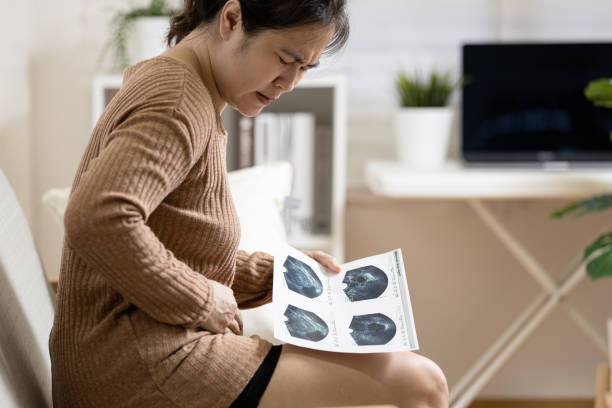Gynaecological ultrasound is an essential examination in any gynaecological examination. The specialist examines the uterus and ovaries using ultrasound. It is usually done transvaginally.
With this technique, we can study the uterus and determine if it presents any alterations such as fibroids, polyps, or malformation …
In this exploration, the ovaries should be studied since it is fundamental in women of reproductive age to know their reserve of ovules (assess when the search for pregnancy should begin).
It can be done any time, depending on what we want to assess. It usually is recommended to do it in the first phase of the menstrual cycle, just after the period.
- When should an abdominal gynaecological ultrasound be performed?
Today it is used very little. It is only recommended in women who have not had sexual intercourse and when the uterus or ovary is vast and cannot be assessed transvaginally.
For this ultrasound, it is essential to have a full bladder.
- Types of gynaecological ultrasounds
There are two types of gynecologic ultrasound: vaginal (transvaginal) and abdominal; both scans can be done in 2D or 3D.
- gynaecological ultrasound hurt
Gynaecological ultrasound does not hurt at all. However, the examination bothers even less than the taking of the cytology. The vaginal probe is done with an empty bladder, which is less annoying than the abdominal ultrasound.
- transvaginal ultrasound
During the gynaecological examination, once the sample for cytology has been taken (when indicated), a probe with lubricant is gently inserted. Usually, the scan lasts a few minutes.
- 3D gynaecological ultrasound consists
It is an ultrasound that has to be done with special equipment and uses a volumetric probe.
It allows us to see the uterus in 3 planes (it is the only one to visualise the coronal plane) and diagnose uterine malformations with the same precision as nuclear magnetic resonance, with the advantage of doing it in a few minutes in the consultation.
Today it is one of the studies recommended by the European Society for Assisted Reproduction (ESHRE) in diagnosing women who have had a repeated miscarriage.
Thanks to it, we can assess uterine septa (walls), uteri with a double cavity,…
It will also allow us to assess the involvement of the uterine cavity by fibroids, polyps and adenomyosis with greater precision than 2D ultrasound.
Another of its applications is the accurate assessment of the follicle count of each ovary, which is essential when assessing the prognosis of women who wish to seek pregnancy (what we call follicular reserve).
- best time to perform a 3D transvaginal ultrasound
It should be in the second phase of the menstrual cycle, after ovulation, so that we can see the endometrial cavity and assess whether it is normal or presents any abnormality: septum, myoma, liquid collection, etc.
Abdominal ultrasound
Abdominal ultrasound is an imaging test that aims to see the internal organs of the abdomen, such as the gallbladder, spleen, pancreas, kidneys or liver, and to diagnose diseases that may originate from a malfunction. Likewise, abdominal ultrasound can encompass pelvic ultrasound, that is, a transabdominal ultrasound which aims to observe the bladder and the organs that derive from it, in the case of women, the ovaries, uterus, cervix and fallopian tubes and, in the case of men, the prostate and seminal vesicles.
SupposeSupposeSupposeormal and Abnormal Abdominal Ultrasound Results
The X-ray. In that case. In that case. In that case, the technician can see and interpret the images emitted by the ultrasound during the test. Still, the doctor is in charge of preparing a complete report with the result of the abdominal ultrasound.
The information that emerges from the study is not measured in numerical values, so the normality or abnormality of the patient’s health status is detected with the interpretation of the images.
Sometimes, the abdominal ultrasound results are not decisive, and the specialist may request additional tests. In any case, this study will be a fundamental step to reaching a correct diagnosis of abdominal pathology.
ultrasound-abdominal-woman
Clinics in Madrid to perform an abdominal ultrasound
As always, we recommend that you have a general health checkup every so often, and, in the case of abdominal ultrasound, the ideal time that should elapse between checkups is two to three years. However, suppose you notice discomfort in the abdominal area. In that case, we recommend that you make an appointment for an ultrasound scan immediately since, in this way, we will be able to detect any disease that originates in this area and apply the best treatments directly to avoid leading to more severe pathologies or more challenging to treat.
At Magnetosur, we have a specialised medical team with a stellar track record behind them, as well as the most cutting-edge machinery on the market, so that you can rest assured that your health is in the best hands.
Results of an abdominal ultrasound
Although it is common for the ultrasound results to take several days to a week to reach the patient, at Magnetosur, we guarantee that you will obtain the test report in just 24 hours through our Patient Area or by hand at our centre. Later, and if the result shows any disease, you can make an appointment with your specialist to start treatment as soon as possible.




